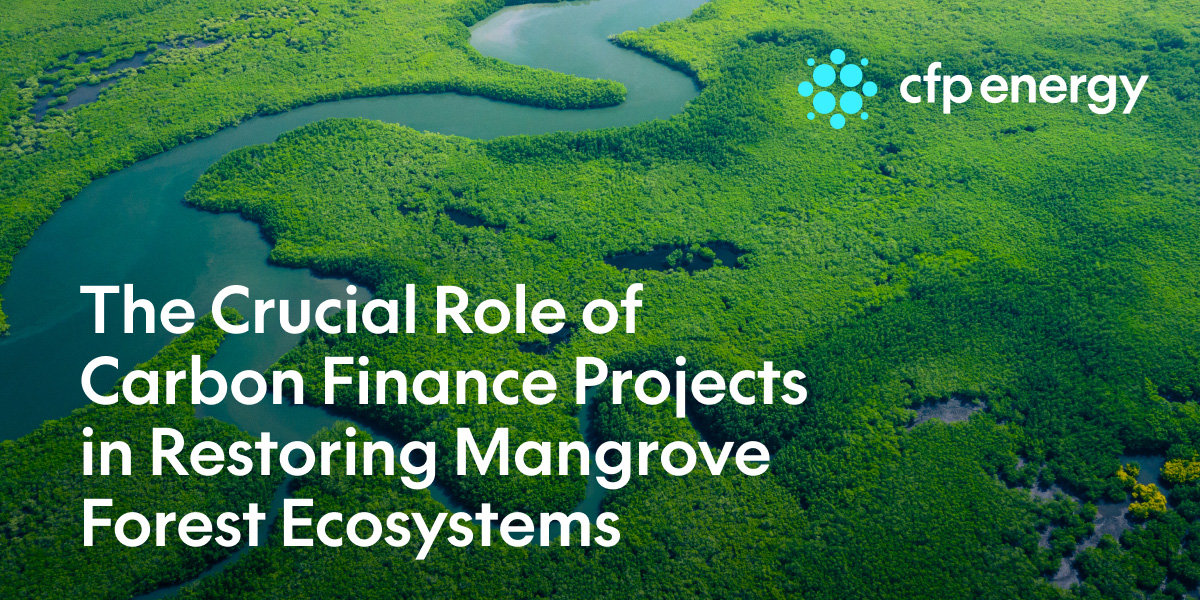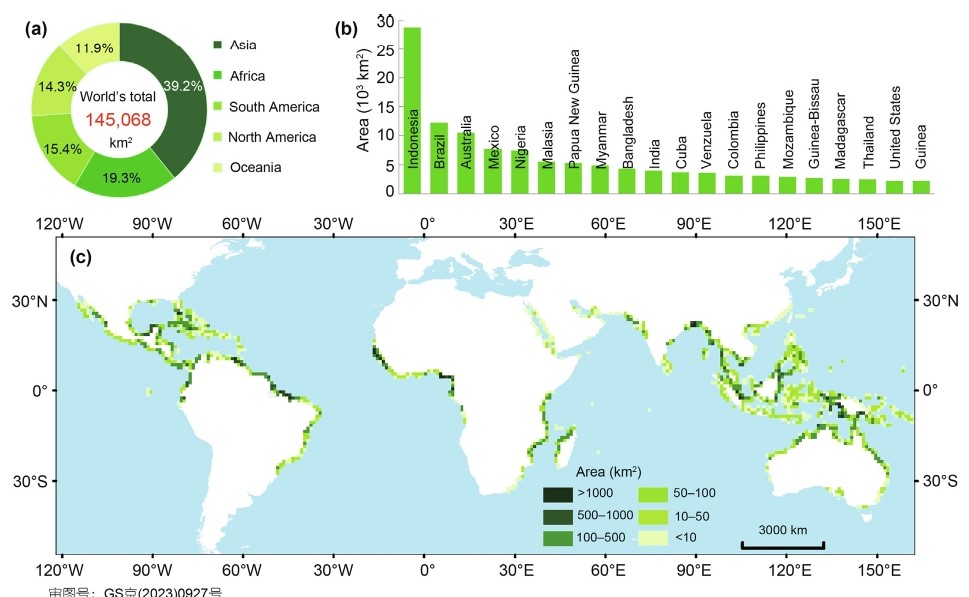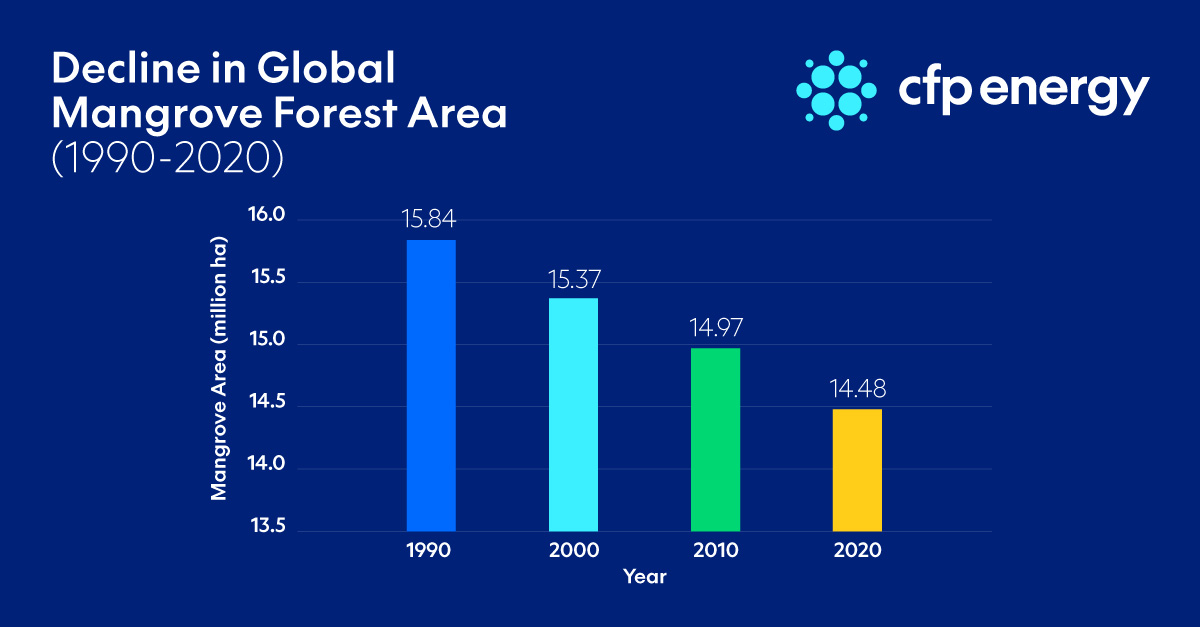We're exhibiting at E-World | Register & Secure your Meeting
Germany, Essen | 11-13 February
Germany, Essen | 11-13 February
21 June 2024
Charlie Robertson

Mangrove forests are invaluable in the battle against climate change, providing essential services such as carbon sequestration, coastal protection, and biodiversity support.
Carbon projects dedicated to restoring these ecosystems hold the promise of significantly advancing global climate objectives. However, to realise their full potential, these projects must overcome various challenges. Addressing these barriers is crucial to unlocking the comprehensive environmental and socioeconomic benefits that the restoration of mangroves offers.
Mangroves are coastal trees and shrubs that thrive in the intertidal zones of tropical and subtropical regions. Found mostly in warm areas with calm coastlines, shallow water, and soft ground, their size and type can vary greatly. In very high salinity environments, mangroves can be short and stunted, while in favourable conditions, they can form lush forests with canopies reaching 30-40 metres (FAO, 2023).
Mangrove forests are powerful carbon sinks, storing more than 6.23 gigatonnes of carbon (equivalent to 22.86 gigatonnes of CO2) worldwide (Leal and Spalding, 2022), and sequestering up to four times more carbon per hectare than tropical forests.

Global distribution of mangrove forests at 10-m resolution
(Source, Jia, Mingming, et al. "Mapping global distribution of mangrove forests at 10-m resolution." Science Bulletin 68.12 (2023): 1306-1316.)
Beyond carbon sequestration, mangroves provide crucial protection against storms, floods, and coastal erosion, safeguarding coastal communities and infrastructure. They support numerous species, offering essential breeding grounds for fish and birds and safe havens for resident and migratory birds and sea turtles.
Mangroves also play a significant role in nutrient cycling and maintaining water quality. Their root systems trap sediments and pollutants, preventing them from reaching coral reefs and seagrass beds. This filtration improves the health of coastal ecosystems, supporting fisheries and tourism. The economic value of these services often surpasses the direct use values from activities like timber extraction and land conversion.
However, between 1990 and 2020, the world lost 1.04 million hectares (6.6%) of its mangrove forests (FAO, 2020). Remaining mangroves face rapid degradation from unsustainable farming, harvesting practices, and urbanisation that alter the water supply, nutrients, and sediments they depend on (Beeston et al., 2023).

(Source, FAO)
The continued degradation of these ecological wonders has resulted in a worldwide surge of interest in mangrove conservation and restoration. In recent years, the voluntary carbon market has emerged as the most effective way of realising the enormous inherent value of these ecosystems.
Before the voluntary carbon market, funding for mangrove conservation was hard to come by, with only a handful of small-scale restoration projects funded globally through philanthropic contributions. Now that the voluntary carbon market is gaining steam, institutional finance on the scale of billions of dollars can start pouring into mangrove conservation.
This transition has already had a transformative effect on the scale at which these restoration projects can operate. For example, one mangrove restoration project located in the Indus Delta in Pakistan (Delta Blue Carbon) will restore 350,000 hectares of mangrove forest – that’s over a third of the mangrove forest that’s been lost worldwide in the last three decades.
Where previously single projects might have been on the scale of tens or hundreds of hectares, now with the advent of the voluntary carbon market individual projects are able to single-handedly reverse global trends in mangrove habitat loss.
Despite the immense ecological value of mangrove ecosystems and the success of the voluntary carbon market in financing their conservation, mangrove carbon projects still encounter significant financial, legal, and technical barriers:
High implementation costs
These include the initial expenses for site selection and preparation, the costs of planting and maintaining mangroves, and the ongoing costs of monitoring and verifying carbon sequestration. These projects often require sophisticated technology and expertise to ensure effective implementation.
Land tenure and carbon rights
Mangrove forests often occupy areas with overlapping jurisdictions or communal land ownership. Disputes can arise over who owns the land and who has the rights to the carbon sequestered in these ecosystems, and can involve communities and private landowners, complicating the process of securing rights to manage and protect these areas.
Technical barriers
Standardised methodologies and robust baseline data are needed to ensure accurate accounting. There is often a lack of local expertise and capacity for effective project implementation. Overcoming these technical barriers requires significant investment in training, research, and the development of robust methodologies.
While the monetisation of carbon credits generated by mangrove restoration projects helps overcome these hurdles, the relative infancy of the voluntary carbon market means that some potential projects still receive too little funding to get up and running.
In the face of these challenges, it is imperative that buyers continue to support mangrove conservation projects. Beyond the long list of environmental services highlighted above, there are two big benefits for companies willing to support mangrove restoration projects right now:
Demonstrate your sustainability credentials
Mangrove restoration projects often involve local communities, providing economic opportunities and fostering sustainable development. They can create jobs, support sustainable fisheries, and improve local infrastructure. By investing in these projects, buyers and investors can contribute to meaningful social and environmental impact, enhancing their corporate social responsibility profiles and demonstrating long-term value creation.

Benefit from early mover advantage
Currently, credits from mangrove and other wetland restoration projects account for only 0.24% of all credits issued (Berkeley Carbon Trading Project, 2024). On top of this, demand for these credits is rapidly expanding. By investing in mangrove projects now, early mover investors and buyers can secure a supply of these highly coveted and increasingly scarce credits and avoid the risk of future price increases.
Given all the above, it is our view that it is a matter of when, not if, the importance of conserving and restoring mangrove ecosystems receives widespread recognition. It is our hope that this increased recognition results in mangrove restoration projects on the scale of Delta Blue Carbon being implemented on a regular basis.
As we feel the effects of a warming earth, coastal ecosystem conservation emerges as a crucial step to mitigate the devastating impacts of climate change. They act as both a huge carbon sink and as a natural barrier between the threats of rising sea levels and hundreds of millions of livelihoods.
It is therefore essential that buyers incorporate coastal ecosystem conservation into their sustainability strategies as soon as possible. In doing so, they can reap the rewards of being at the frontier of the most exciting nature-based solution to climate change.
The approval of Article 6 of the Paris Agreement at COP29 in Baku, marks a historic moment for global climate action. Article 6 introduces market-based mechanisms that enable countries to transfer emissions mitigations internationally to meet climate targets. After nine years of negotiations, nations have finalised the frameworks for its two main components, Article 6.2 and 6.4, fully enabling their implementation.
The UK’s newly released Principles for Voluntary Carbon and Nature Market Integrity represent a significant step forward in leveraging voluntary carbon markets (VCMs) to lower global emissions, attract climate finance, and restore nature. These principles reflect a growing international trend toward creating structured, transparent standards for market participation.
As the aviation industry navigates the first year of the Carbon Offsetting and Reduction Scheme for International Aviation (CORSIA) Phase 1 (2024–2026), this week’s approvals of additional carbon crediting standards have influenced the market landscape, introducing both opportunities and complexities.